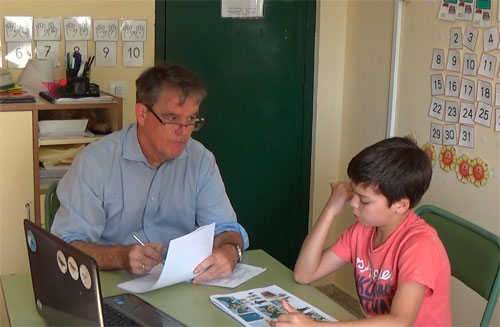What Silent Sign reveals about output (inter-language).
The advantages of the Silent Sign tool regarding output.

Comic strip of Penguin Story.
Although experienced language teachers would expect their students to score higher in controlled written tests than fluency oral tests containing the same material, they often despair when students say things like: "He is go"; "He are going"; "He go"; etc. after performing well on written tests. There exists a yawning gap in between written language produced during controlled tests and spoken output in fluency tasks (see Krashen's Monitor Model 1977). The Silent Sign input tool is thought to allow students to access quasi-fluency practice (Bilbrough 2017). It serves as an intermediary exercise before releasing students into fluency output tasks. Furthermore, Silent Sign provides the teacher with a more accurate indicator of the true interlanguage content each student possesses.
In this test I set up after just fifty hours of my PhD experimental course (two one-hour classes per week), ten-year old Spanish students did a written gap-fill multiple choice test on the past continuous structure. Students performed well in general on the written test.
A few days later, the same students carried out an oral test. The students were asked to listen once to a story in the past that included past continuous utterances. Students were then asked to tell the same story immediately afterwards using a text-free comic strip as a memory aid to the story events. (This technique is called Elicited Imitation Testing, EIT).

Student 1 tells story from comic strip.
Students had received gesture-based classes with Silent Sign including stories and anecdotes with past continuous. I noticed that many students were failing to produce the past continuous form correctly during Silent Sign. I could then make a successful prediction about the outcomes of the fluency tasks such as the oral exam. My thinking here is that in a non-gesture course approach, the teacher would have less evidence to successfully predict oral test outcomes and may have expected better performances if based on written test results alone.
This student was one of the few (there were a few at least!) who correctly constructed the past continuous in some instances. We shall use as a reference point picture 4 of the Penguin Story (see comic strip above). In the original story, students heard "One day, Policeman Plod was walking along the street..."
Below, I include a selection of other utterances from the same test with reference to picture 4. There are six versions here but only the last student managed the same utterance as in the story and an accurate one:
...was walking along the street...
Despite correctly uttering past continuous, Student 1 failed to use past simple in much of the rest of the story. Other students were more successful with past simple. Again, this was predicted during the course by the use of Silent Sign. Students would either occasionally correct themselves (present to past) or, after prompting from the teacher. This self-correction from present to past represents a transitional stage when learners have still not completely acquired a consistent past marking. This transitional period from present to past has been described by Bardovi-Harlig (2000), and Dietrich et al. (1995). Also, Lightbown and Spada explain that:
"[...] at a given point in time, learners may use sentences typical of several different stages. It is perhaps better to think of a stage as being characterised by the emergence and increasing frequency of a particular form rather than the disappearance of an earlier one" (1999:85).
Notice here how Student 2 correctly says in the past "saw", "said", "didn't take", "didn't enjoy" (though prefers present with the other verbs).

Though no gestures were used by the examiner in this test, Student 2 signs some words presumably to help express himself (here: "he/him").
Conclusions.
Having a gesture code in the English language classroom provides the teacher with insights into the learners' inter-language. The Silent Sign technique allows the teacher to delve into the recesses of the students' internal language systems and learn to anticipate what they will probably be capable of producing during output (fluency practice). Furthermore, this discovery process occurs during class instruction time. The teacher just needs to concentrate on individual students during choral Silent Sign for short periods or key moments to glean their interlanguage knowledge. The advantage of this process is that the teacher is able to make a fairly accurate evaluation of student interlanguage without getting involved in time-consuming individual oral testing. Or when he/she does test, it is done with a clearer understanding of what the results will be and whether they are truly representative. Finally, through the use of the Silent Sign technique, the teacher can detect in real time where weaknesses lie in form or vocabulary knowledge so that more class work can be done in those areas.
Article based on findings from PhD thesis. (Bilbrough 2017)
References.
Bardovi-Harlig, K. (2000). Tense and aspect in second language acquisition: form, meaning and use. Language Learning Monographic Series. Malden, Mass,: Blackwell.
Bilbrough M. A. (2017). Accelerating input and exposure in the English language classroom. IATEFL 2016 Birmingham conference selections.
Dietrich. R., W. Klein, and C. Noyau (eds.). 1995. The Acquisition of Temporality in s Second Language. Amsterdam: John Benjamins.
Krashen, S. (1977). Some issues relating to the monitor model. In Brown, H; C. Yorio, C and R. Crymes. Teaching and learning English as a Second Language: Trends in Research and Practice: On TESOL '77: Selected Papers from the Eleventh Annual Convention of Teachers of English to Speakers of Other Languages, Miami, Florida, April 26 - May 1, 1977. Washington, DC: Teachers of English to Speakers of Other Languages. pp. 144-158.
Lightbrown, P.M. and N. Spada. (1999). How languages are learned, revised edition. Oxford: Oxford University Press.
See next article - Form Correction and Explanations...
Copyright © 2021 M. A. Bilbrough
All rights reserved